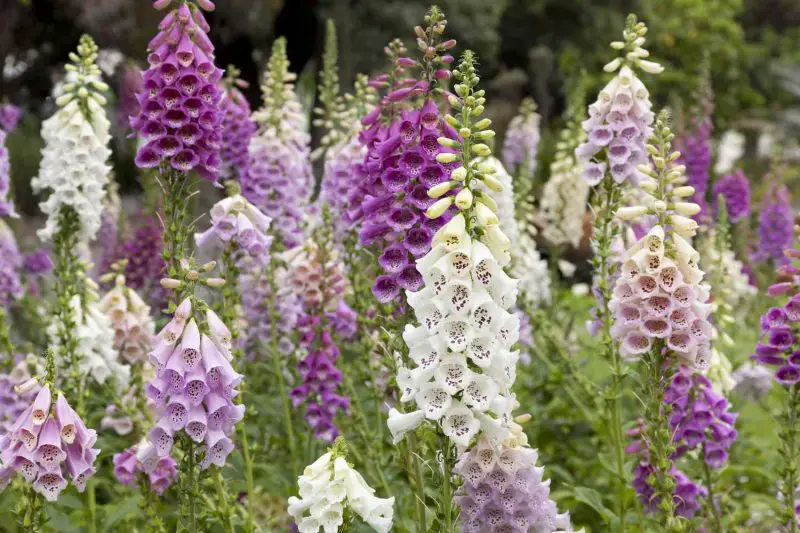Foxglove is a captivating garden favorite known for its tall, elegant spikes adorned with vibrant, tubular flowers that instantly add charm and vertical drama to any outdoor space. Whether you’re a seasoned gardener or a beginner, learning how to grow foxglove opens the door to a stunning floral display that attracts pollinators and brightens your garden from late spring through summer.
This versatile plant thrives in a variety of climates and garden styles, making it a must-have for borders, cottage gardens, and wildflower meadows. In this guide, you’ll discover essential tips on planting, caring for, and maintaining foxglove to ensure your blooms are healthy, abundant, and breathtaking season after season.
Understanding Foxglove and Its Garden Appeal

Foxglove (Digitalis purpurea) is a striking and unique addition to any garden, cherished for its tall, graceful flower spikes that can reach heights of up to four feet or more. These spikes are adorned with bell-shaped, tubular flowers that come in a variety of colors including deep purples, soft pinks, creamy whites, and even speckled yellows. The intricate patterns inside each flower not only add visual interest but also serve as natural guides for pollinators like bees and hummingbirds, making foxglove a valuable plant for supporting local ecosystems.
Beyond its aesthetic appeal, foxglove holds a rich history as a medicinal plant. While all parts of the plant are toxic if ingested, compounds derived from foxglove have been used in heart medications for centuries. This dual nature—beautiful yet potent—adds to the plant’s allure. Gardeners appreciate foxglove not only for its vertical structure and vibrant colors but also for its ability to thrive in shaded or partially shaded areas, where many other flowering plants struggle. Its adaptability and natural charm make foxglove a staple in cottage-style gardens, woodland borders, and naturalized areas, providing an elegant focal point and enhancing biodiversity.
Choosing the Right Location for Foxglove
Selecting the ideal location for planting foxglove is crucial to its success. Foxgloves naturally grow along woodland edges and shaded clearings, so replicating these conditions in your garden encourages healthy growth and spectacular blooms. Choosing a spot that balances light, soil, and moisture will allow your foxglove plants to thrive year after year.
Light Requirements
Foxgloves perform best in partial shade or dappled sunlight, which mimics the filtered light they receive in their native woodland habitats. This balance helps protect the plants from intense afternoon heat and prevents leaf scorch—a common problem in hotter climates. In cooler areas, foxgloves can tolerate and even benefit from full sun exposure, which encourages strong stems and more prolific flowering. Ideally, a location that receives morning sun followed by afternoon shade is perfect. This pattern helps keep the soil temperature moderate and retains moisture, reducing stress on the plants during warm days.
Too much direct sunlight, especially during the hottest hours, can cause leaves to wilt, become crispy, and reduce the overall lifespan of the blooms. Conversely, too much shade can lead to leggy plants with fewer flowers. Observing how sunlight moves across your garden throughout the day will help you pinpoint the best spot for foxglove.
Soil Conditions
Soil quality directly affects foxglove health and flowering potential. Foxgloves thrive in well-draining soil that is rich in organic matter, offering both fertility and moisture retention without becoming waterlogged. Heavy clay soils tend to retain excess water, creating conditions that can cause root rot and fungal diseases, which are detrimental to foxgloves.
For optimal growth, aim for a loamy soil texture that balances sand, silt, and clay. This type of soil drains well but still holds enough moisture to sustain the plant. Foxgloves prefer slightly acidic to neutral soils with a pH ranging from 5.5 to 7.0, which supports nutrient availability and root health.
Before planting, it’s beneficial to prepare the soil by loosening it to a depth of 12 to 15 inches. Incorporate generous amounts of organic amendments such as compost, aged leaf mold, or well-rotted manure to improve soil structure, increase fertility, and boost microbial activity. These amendments help create a loose, nutrient-rich environment that encourages deep root development and strong plant vigor.
If your garden soil is heavy clay, consider creating raised beds or mounded rows to enhance drainage. Alternatively, mixing coarse sand or fine gravel into the planting area can help prevent waterlogging. For sandy soils that drain too quickly and dry out, adding organic matter helps retain moisture and provides essential nutrients.
How to Plant Foxglove for Optimal Growth
Successful planting lays the foundation for healthy foxglove plants. Understanding seed sowing and transplanting techniques ensures strong seedlings and long-lasting garden plants.
Growing Foxglove from Seeds
Foxglove readily self-seeds in the garden, but starting from seed allows control over variety and timing. Sow seeds indoors 8 to 10 weeks before the last frost date or sow directly outdoors in late spring or early fall. Seeds require light to germinate, so press them lightly on the soil surface without covering. Maintain consistent moisture and moderate temperatures (65–70°F or 18–21°C) for germination, which usually occurs within 14 to 21 days.
Thin seedlings once they develop true leaves to avoid overcrowding, which can encourage disease. Transplant seedlings outdoors when they reach 4 to 6 inches tall, spacing them 12 to 18 inches apart for air circulation.
Transplanting Nursery Plants
Transplant nursery-grown foxglove plants in early spring after the last frost when the soil is warm. Dig holes slightly larger than the root ball and gently loosen roots if they’re compacted. Plant so the crown sits at soil level, then backfill and firm the soil to remove air pockets. Water thoroughly after planting to settle the soil.
Apply a 2- to 3-inch layer of mulch around the base to retain moisture and regulate temperature, keeping it away from the stem to avoid rot. Water regularly during the first weeks to keep soil moist but not soggy. Providing temporary shade during hot weather helps young plants adjust and thrive in their new spot.
After transplanting, keep an eye on your foxglove plants for signs of stress such as wilting or yellowing leaves. Promptly adjust watering and provide protection from strong winds or intense sun to support healthy recovery and vigorous growth.
Caring for Foxglove Throughout the Growing Season
Providing consistent and attentive care throughout the growing season is essential to keep foxglove plants healthy, encourage lush foliage, and produce abundant, vibrant blooms. Understanding their specific water, nutrient, and soil needs helps you maximize the plant’s performance.
Watering Needs
Foxglove thrives in soil that remains consistently moist but well-drained. It’s important to water deeply about once or twice per week, depending on rainfall and climate conditions. During prolonged dry spells or hot weather, increase watering frequency to prevent stress and maintain steady growth. However, foxglove does not tolerate waterlogged or soggy soil, which can lead to root rot and fungal infections. To minimize the risk of foliar diseases like powdery mildew or leaf spot, avoid overhead watering. Instead, use drip irrigation or water at the base of the plant to keep foliage dry and promote healthy development.
Fertilizing Foxglove
Feeding foxglove with the right nutrients supports vigorous growth and prolific blooming. Begin by applying a balanced slow-release fertilizer in early spring to provide steady nutrition through the growing season. This helps the plant build strong stems and leaves. Supplement this with a liquid fertilizer every 4 to 6 weeks during active growth and flowering to boost bloom size and quantity. It’s important to avoid over-fertilizing, especially with high-nitrogen fertilizers, as excess nitrogen encourages leafy growth but can reduce flower production and weaken stems, making plants more susceptible to lodging.
Mulching and Soil Maintenance
Mulching is a vital practice to sustain healthy foxglove growth. Spread a 2- to 3-inch layer of organic mulch, such as shredded bark, compost, or well-aged leaf mold, around the base of the plants. Mulch helps retain soil moisture by reducing evaporation, suppresses competing weeds that can rob nutrients, and gradually improves soil structure as it decomposes. It also helps moderate soil temperature, protecting roots from extreme heat or cold fluctuations. Refresh the mulch layer annually or as needed to maintain these benefits. Be sure to keep mulch a few inches away from the plant stems to prevent moisture buildup that could promote rot.
Managing Common Pests and Diseases
Pest Control
Common pests that affect foxglove include aphids and slugs. Aphids are small, soft-bodied insects that suck sap from the leaves and stems, causing distortion, yellowing, and sometimes transmitting viruses. To control aphids naturally, encourage beneficial insects such as ladybugs, lacewings, and parasitic wasps, which prey on aphids and help keep their populations in check. For slugs, which chew irregular holes in foliage and can damage young plants severely, use physical barriers like copper tape or crushed eggshells around the base of plants. Organic slug pellets or beer traps can also be effective without harming wildlife. Regularly inspect your foxgloves, especially the undersides of leaves and near the soil line, and promptly remove any pests or damaged plant parts to reduce further infestations.
Disease Prevention
Foxgloves can be susceptible to fungal diseases like powdery mildew and leaf spot, particularly in humid or poorly ventilated environments. Powdery mildew appears as a white, powdery coating on leaves, while leaf spot causes dark, irregular spots that may lead to leaf drop. To prevent these diseases, space plants adequately to promote good air circulation, which helps foliage dry quickly after watering or rain. Water foxgloves early in the morning and avoid overhead irrigation to minimize moisture lingering on leaves. Remove and destroy any infected leaves or debris promptly to reduce sources of fungal spores. In severe cases, fungicidal sprays may be used, but prevention through proper cultural practices remains the best approach.
Propagating Foxglove for Continuous Blooms
Self-Seeding for Natural Spread
Foxglove is well known for its ability to self-seed, making it easy to maintain a naturalized garden filled with these charming flowers. At the end of the blooming season, allow some of the flower spikes to remain intact and dry on the plant. As the seed heads mature and dry, they release numerous tiny seeds that fall to the ground, germinating readily the following spring. To encourage successful self-seeding, avoid cutting back the spent flowers too early. You can also gently collect seeds and scatter them in desired locations for controlled propagation. This natural method helps maintain a steady population of foxglove plants without the need for constant replanting.
Dividing Foxglove Clumps
While foxgloves are primarily biennial—growing foliage in the first year and flowering in the second—some varieties behave as short-lived perennials and can form clumps over time. Dividing these clumps can rejuvenate older plants and encourage healthier growth. The best time to divide foxglove is in early spring or early fall when the plant is not in active bloom. Carefully dig up the clump, taking care to preserve as much of the root system as possible. Separate the clump into smaller sections with healthy roots and shoots, then replant immediately at the same depth. Water thoroughly to help the divisions settle in and reduce transplant shock. Dividing also helps control overcrowding and promotes better air circulation, reducing disease risk.
Extending Foxglove Bloom Time
Maximizing the flowering period of foxglove plants involves strategic planting and regular maintenance. By staggering planting times and practicing effective deadheading, gardeners can enjoy continuous color and vibrant blooms throughout the season.
Staggered Planting
One of the best ways to ensure a prolonged display of foxglove flowers is to sow seeds or transplant young plants at intervals spaced about 3 to 4 weeks apart during the planting season. Starting early in spring, successive sowings result in plants reaching maturity and flowering at different times, creating a natural succession of blooms. This method not only extends the flowering window from late spring into summer but also provides a steady supply of fresh blossoms for cutting and garden enjoyment. When planning staggered planting, be sure to adjust watering and care to meet the needs of younger and older plants simultaneously.
Deadheading and Maintenance
To encourage foxgloves to produce additional flowers and prevent self-seeding where it’s not desired, regularly remove spent flower spikes. Use clean pruning shears to cut just above a healthy leaf whorl or side shoot. This pruning redirects the plant’s energy from seed production back into creating new flowers. In addition to deadheading, proper seasonal maintenance is important. After the first frost in fall, cut back the foxglove foliage to ground level. This helps the plant enter dormancy cleanly and reduces the risk of disease. Removing old foliage also tidies the garden and prepares the site for new growth in the following spring.
Overwintering Foxglove Plants
Mulching for Winter Protection
Applying a thick layer of mulch around the base of foxglove plants in late fall is essential for insulating the roots against freezing temperatures and harsh weather fluctuations. Use organic materials like straw, shredded leaves, pine needles, or bark mulch to create a protective blanket that helps maintain more stable soil temperatures. Mulch also prevents soil from freezing and thawing repeatedly, which can damage root systems. Be sure to spread mulch evenly around the root zone, leaving a small gap around the plant’s crown to prevent moisture buildup that could cause rot. In addition to temperature regulation, mulch helps conserve soil moisture during dry winter months.
Growing Foxglove in Cold Climates
For gardeners in colder USDA zones, extra steps are needed to successfully grow foxglove. Starting seeds indoors 6 to 8 weeks before the last frost date gives seedlings a head start and protects them from harsh early spring conditions. Purchasing nursery-grown plants in early spring is another reliable option to avoid cold stress. While foxglove seeds can be sown outdoors in fall, they may not always survive extremely cold winters without additional protection. However, exposure to cold stratification during winter helps break seed dormancy and enhances germination rates in spring. If sowing seeds outdoors, consider covering the planting area with a cold frame or garden fleece to shield seeds from severe frost and temperature swings.
Combining Foxglove with Companion Plants
Combining foxglove with suitable companion plants not only enhances the visual appeal of your garden but also promotes a healthier growing environment. Foxgloves pair well with plants that have contrasting textures and bloom times, creating a layered and dynamic garden display. Tall, airy plants like delphiniums and lupines complement the spiky form of foxgloves, while lower-growing perennials such as hostas or ferns provide a lush, leafy base that helps retain soil moisture and suppress weeds. Additionally, planting foxgloves alongside bee-friendly flowers like lavender or catmint can attract beneficial pollinators, improving flower production and overall garden vitality. Proper companion planting can also reduce pest pressure by confusing or repelling common pests that might target foxgloves. When selecting companion plants, consider similar soil and moisture requirements to ensure all plants thrive together. Integrating foxgloves thoughtfully with compatible companions will create a vibrant, healthy, and balanced garden ecosystem.
Frequently Asked Questions About Growing Foxglove
What is the best time to plant foxglove seeds?
The ideal time to plant foxglove seeds is in early spring after the last frost, or in late summer to early fall. Starting seeds indoors about 6 to 8 weeks before the last frost can give seedlings a head start. Fall sowing outdoors is also common and benefits from natural cold stratification, which improves germination in spring.
How much sunlight do foxglove plants need?
Foxgloves prefer partial shade to dappled sunlight, especially in warmer climates. They thrive when receiving morning sun and afternoon shade. In cooler regions, foxglove can tolerate full sun but may require protection from harsh midday heat to prevent leaf scorch and stress.
How often should I water my foxglove plants?
Foxglove likes consistently moist but well-drained soil. Water deeply once or twice per week, increasing frequency during dry or hot periods. Avoid waterlogging, which can cause root rot. Using drip irrigation or watering at the base helps keep foliage dry and reduces fungal disease risk.
Can foxglove tolerate cold winters?
Foxgloves can survive mild winters if protected properly. Applying a thick mulch layer in late fall insulates roots from freezing temperatures. In colder zones, starting seeds indoors or planting nursery-grown plants in spring is recommended. Outdoor-sown seeds require cold stratification to germinate well and may need extra protection from harsh frost.
How do I encourage continuous blooms from foxglove plants?
To extend the flowering period, practice staggered planting by sowing seeds or transplanting at intervals spaced 3 to 4 weeks apart. Regular deadheading of spent flower spikes encourages the plant to produce new blooms and prevents premature seed drop. Cutting back foliage after the first frost helps plants enter winter dormancy and prepares them for vigorous growth next season.
Conclusion
Growing foxglove can transform your garden with its towering, colorful blooms and classic charm. By selecting the right location, providing consistent care, managing pests and diseases, and planning for succession, you can enjoy stunning foxglove displays year after year. Whether starting from seed or nursery plants, these essential tips will guide you toward success in cultivating this beloved garden favorite.






